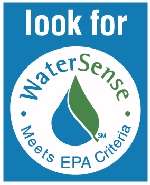THREE HELPFUL TIPS
1. For maximum efficiency, get a low-flow showerhead with a shut-off valve. This allows you to turn off the water while soaping up, and then turn it back on instantly without having to readjust the temperature.
2. To save even more on water usage install a shower timer.
3. If one in every 10 North American homes would upgrade a full bathroom with WaterSense labeled fixtures, we could save about 74 billion gallons of water (280 billion litres) and and about $1.6 billion on our utility bills nationwide per year!
Q - How much water can be saved?
A - ENOUGH TO KEEP THE NIAGARA WATER FALLS FLOWING FOR 35 HOURS!!!!!! |
|

This WaterSense label certifies that the product has passed the criteria set by the government. Click on the label for more information |
|
| Low-flow Showerheads |
|
|
Low-flow showerheads will save on water usage, lower energy costs and contribute to a greener environment. Many older homes still have the original conventional showerhead which use as much as eight gallons, or 30 litres per minute. A low-flow showerhead uses up to 60% less water.
STATISTICS
- In the average home up to 25% of all hot water usage and up to 15% of total energy use can be attributed to showers.
- Without a low-flow showerhead a ten minute shower can use as much as 42 gallons or 190 litres of hot water.
- By installing a low-flow showerhead a family of three could save up to $100 a year on energy costs.
- If only 10,000 families would replace the old conventional showerhead with a low-flow model the savings would be enough to provide power to 300 households for up to one year.
TYPES, AFFORDABILITY, INSTALLATION, MODELS
Even though there is up to 60% less water you still can have that "full shower feeling" due to increased water velocity. This is obtained by forcing the water through very small apertures in the showerhead. Many low-flow models feature multiple flow settings.
- Types: There are basically two types of low-flow showewrheads, aerating and non-aerating.
- Aerating showerheads mixes air into the water. The air maintains steady pressure and results in an even, full shower spray. Aerating showerheads are the most popular kind of low-flow showerhead.
- Non-aerating showerheads do not use air, maintain a warmer water temperature and have a stronger pulsing spray for a better massage.
- Affordability: Prices range from as low as $20 to as high as $300 for designer models depending on materials used. Payback for your new low-flow showerhead starts with your first shower after installation has been completed. Rate of savings depends on how often you shower.
- Models: There is a wide variety of low-flow showerheads to choose from. One major home improvement store had more than 30 on display. Low-flow showerheads are either fixed or hand-held. Hand held showerheads are usually more expensive than fixed models.
- Installation: This is a simple job but care should be taken when removing the old showerhead from the shower arm or gooseneck pipe.
(my reminder note 'in box' dad)
If too much force is used this pipe can break where it is connected to the main water supply pipe. To prevent this from happening cover the gooseneck pipe with a rag and use water pump pliers to prevent the pipe from moving while you unscrew the old showerhead. |
|
|
IT IS THE LAW!
The flow through rate for low-flow showerheads cannot be more than 2.5 gallons per minute, GPM, in the US (since 1992) or more than 9.5 litres per minute in Canada (since 2008). WaterSense certified products, including low-flow showerheads, are available in the US as well as in Canada. WaterSense considers low-flow shower heads to have a GPM of 2.0 or less. For more information on the EPA's WaterSense Program, go to: http://www.epa.gov/WaterSense/index.html.
NOTE. This article and the use of the the WaterSense label has been approved by the Environmental Protection Agency (EPA) of the United States Government |
|
|
|
|
Back to Top |
|